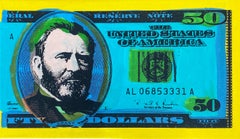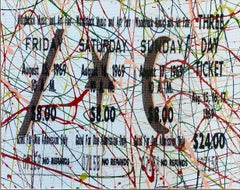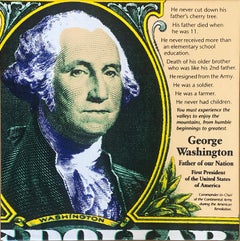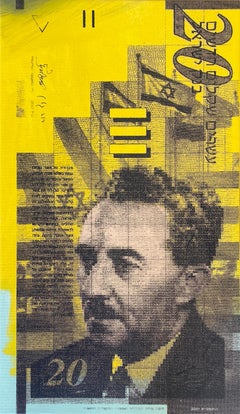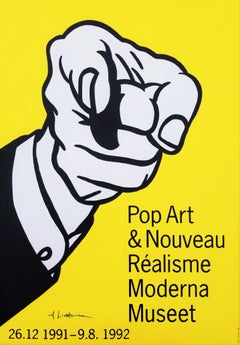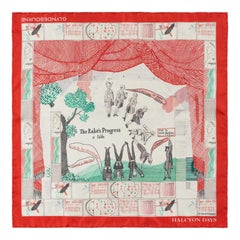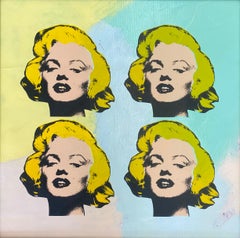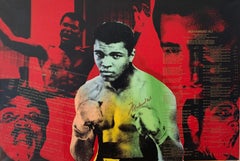Steve Kaufman Figurative Prints
American, 1960-2010
Steven Alan Kaufman was an American pop artist, fine artist, sculptor, stained glass artist, filmmaker, photographer and humanitarian. His entry into the world of serious pop art began in his teens when he became an assistant to Andy Warhol at The Factory studio, who nicknamed him "SAK".to
1
2
1
Overall Width
to
Overall Height
to
4
88
859
382
378
308
4
2
1
1
3
3
3
2
2
2
1
1
4
4
4
4
Artist: Steve Kaufman
50 Dollar Bill
By Steve Kaufman
Located in Hollywood, FL
Artist: Steve Kaufman
Title: 50 Dollar Bill
Medium: Screenprint on Canvas
Edition: AP 5 of 50
Year: 2000-2010
Notes: Hand Signed and Numbered by the artis...
Category
Early 2000s Pop Art Steve Kaufman Figurative Prints
Materials
Canvas, Screen
Woodstock Ticket
By Steve Kaufman
Located in Hollywood, FL
Artist: Steve Kaufman
Title: Woodstock Ticket
Medium: Screenprint on Canvas
Size: 17 x 14 inches
Edition: 32 of 50
Year: 2000-2010
Notes: Hand Sign...
Category
Early 2000s Pop Art Steve Kaufman Figurative Prints
Materials
Canvas, Screen
George Washington: Father of Our Nation
By Steve Kaufman
Located in Hollywood, FL
Artist: Steve Kaufman
Title: George Washington: Father of Our Nation
Medium: Screenprint on Canvas
Size: 20 x 20 Inches
Edition: 97 of 200
Year: 2000-2010
Notes: Hand Signed and ...
Category
Early 2000s Pop Art Steve Kaufman Figurative Prints
Materials
Canvas, Screen
Israel 20 Shekel 1998 Circulated Bank Note
By Steve Kaufman
Located in Hollywood, FL
Artist: Steve Kaufman
Title: 20 Shekel 1998 Circulated Bank Note
Medium: Screenprint on Canvas
Size: 14 x 27.5 Inches
Edition: 28 of 50
Year: 2007
Notes: Israel 20 Shekel 1998 Circul...
Category
Early 2000s Pop Art Steve Kaufman Figurative Prints
Materials
Canvas, Screen
Related Items
Pop Art & Nouveau Réalisme Moderna Museet (Finger Pointing) Poster (Signed)
By Roy Lichtenstein
Located in Saint Augustine, FL
Artist: (after) Roy Lichtenstein (American, 1923-1997)
Title: "Pop Art & Nouveau Réalisme Moderna Museet (Finger Pointing)"
*Signed by Lichtenstein in...
Category
1990s Pop Art Steve Kaufman Figurative Prints
Materials
Screen
$8,000
H 39.38 in W 27.63 in
David Hockney, The Rake's Progress 100% Silk British Pocket Scarf in bespoke box
By David Hockney
Located in New York, NY
David Hockney
The Rake's Progress Silk Pocket Scarf, ca. 2020
100% silk scarf made in Italy and printed in the UK, held in the original presentation box
16 1/10 × 16 1/10 inches
Bear...
Category
2010s Pop Art Steve Kaufman Figurative Prints
Materials
Silk, Screen
$1,000
H 16.1 in W 16.1 in
Heart & Soul
By Mr. Brainwash
Located in New York, NY
Heart & Soul, 2020
Signed, dated, numbered in pencil with thumbprint in verso
Screenprint on paper
30 x 22 inches
Edition 84 of 85
Category
2010s Pop Art Steve Kaufman Figurative Prints
Materials
Screen
Jonathan Winters Screenprint Canvas Painting Airplane Hollywood Hang Ups Pop Art
By Jonathan Winters
Located in Surfside, FL
Overall 21 X 27 image is 17.25 X 23.5
This is a mixed media print on canvas by beloved comedian and artist Jonathan Winters.
This one depicts old biplane airplanes and parachutes
...
Category
1980s Pop Art Steve Kaufman Figurative Prints
Materials
Canvas, Screen
Peter Blake 110 Years of Vauxhall, Pop tribute to Art Car, British flag signed/n
By Peter Blake
Located in New York, NY
Peter Blake
110 Years of Vauxhall, 2013
Silkscreen on Linen
Hand signed and numbered 80/110 by the artist on the front
9 × 17 inches
Unframed
Sir Peter Blake is one of the most successful British Pop artists from the fabulous 1960s, and his work can be found in major museums and collections worldwide. He is best known for creating the sleeve design of the Beatles' album Sgt. Pepper's Lonely Hearts Club Band. It was with the Young Contemporaries exhibition of 1961, where he exhibited alongside David Hockney and R.B. Kitaj, that Blake rose to prominence. Blake created this limited edition print, a tribute to the Art Car, exclusively for the Vauxhall Art Car Boot Fair 2013. The work sold out completely in less than 15 minutes. It is in excellent condition. Pencil signed and numbered from the limited edition of only 110. The excitement of the event was described in a British news report as follows: "Now in its 100th year, the fair it featured work by over 70 renowned artists including Sir Peter Blake, Gavin Turk, Emin International, Polly Morgan, Mat Collishaw...
Category
2010s Pop Art Steve Kaufman Figurative Prints
Materials
Linen, Screen
HOPE (R/W/B), large original 4 panel painting
By Robert Indiana
Located in Aventura, FL
Acrylic and silkscreen ink on triple primed canvas. Hand signed, dated, titled and numbered "P/P" on verso by Robert Indiana. Printer's Proof edition.
Total of 4 panels. Each pan...
Category
Early 2000s Pop Art Steve Kaufman Figurative Prints
Materials
Canvas, Screen, Acrylic
Bert Stern "Marilyn Monroe Gold and Champagne" 1973 Signed Photo Silkscreen
By Bert Stern
Located in Miami, FL
BERT STERN – "MARILYN MONROE (GOLD/CHAMPAGNE)"
Photo Silkscreen ⚜ Hand Signed ⚜ Numbered ⚜ Framed
AN ICONIC IMAGE FROM "THE LAST SITTING" SERIES
This original photo silkscreen by Be...
Category
1970s Pop Art Steve Kaufman Figurative Prints
Materials
Photographic Paper, Screen
$9,000
H 39 in W 39 in D 1.25 in
NICK SMITH - BEAUTY. Limited edition hand signed Pop Art Design Modern
By Nick Smith
Located in Madrid, Madrid
NICK SMITH - BEAUTY
Date of creation: 2022
Medium: Giclée and screen printed varnish on paper
Edition: 66
Size: 62 x 60 cm
Condition: Brand new, in mint conditions and never framed
...
Category
2010s Pop Art Steve Kaufman Figurative Prints
Materials
Varnish, Archival Paper, Giclée, Screen
$4,433
H 24.41 in W 23.63 in
NICK SMITH - FAME. Limited edition hand signed Pop Art Design Modern
By Nick Smith
Located in Madrid, Madrid
NICK SMITH - FAME
Date of creation: 2022
Medium: Giclée and screen printed varnish on paper
Edition: 66
Size: 62 x 60 cm
Condition: Brand new, in mint conditions and never framed
De...
Category
2010s Pop Art Steve Kaufman Figurative Prints
Materials
Varnish, Archival Paper, Giclée, Screen
$4,433
H 24.41 in W 23.63 in
The souper dress
By Andy Warhol
Located in Jerusalem, IL
A wonderful piece of unknown edition by Andy Warhol.
A silkscreen print on a Cellulose and Cotton dress.
Fearing the artist's trade mark Campbell's soup can.
In very good condition.
Category
1960s Pop Art Steve Kaufman Figurative Prints
Materials
Textile, Screen
KAWS - SHARE Hand signed & numbered - Modern Art Companion & Pink BFF Grey Pink
By KAWS
Located in Madrid, Madrid
KAWS - SHARE
Date of creation: 2022
Medium: Screen print on Stonehenge gray paper
Edition number: 118/500
Size: 50.8 x 40.6 cm
Condition: In mint conditions, brand new and never fram...
Category
2010s Pop Art Steve Kaufman Figurative Prints
Materials
Paper, Screen
$15,309
H 20.01 in W 15.99 in
Warhol Unlimited, large silkscreen poster from the Musee d'Art Moderne in Paris
By Andy Warhol
Located in New York, NY
Andy Warhol (After)
Warhol Unlimited, 2015
Silkscreen on thin linen canvas backing
63 × 47 inches
Unframed
This large, stunning silkscreen poster was published on the occasion of the...
Category
2010s Pop Art Steve Kaufman Figurative Prints
Materials
Canvas, Linen, Screen
Previously Available Items
Marilyn Quad
By Steve Kaufman
Located in Hollywood, FL
Artist: Steve Kaufman
Title: Marilyn Quad
Medium: Screenprint on Canvas
Size: 13.5 x 13.5 inches
Edition: 15 of 50
Year: 2000-2010
Notes: Hand Signed and Numbered by the artist on...
Category
Early 2000s Pop Art Steve Kaufman Figurative Prints
Materials
Canvas, Screen
Mohammed Ali Pop Art Color Screenprint with Real Mohammed Ali Signature
By Steve Kaufman
Located in New York, NY
Steve Kaufman
MOHAMMED ALI, 1996.
Color screenprint on stretched canvas, 31 x 45 ¾".
Signed in ink on verso by artist, also signed by Mohammed Ali lower...
Category
1990s Pop Art Steve Kaufman Figurative Prints
Materials
Canvas, Color
Einstein State I
By Steve Kaufman
Located in New York, NY
Hand painted oil over silkscreen canvas
AP 3 of 50
Signed SAK and numbered on verso
Category
Late 20th Century Pop Art Steve Kaufman Figurative Prints
Materials
Canvas, Oil, Screen
Steve Kaufman figurative prints for sale on 1stDibs.
Find a wide variety of authentic Steve Kaufman figurative prints available for sale on 1stDibs.
